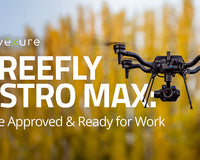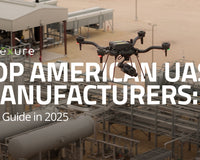Solar power is surging worldwide, with more than 100 GW of capacity now installed in the United States alone—enough to power roughly 18.6 million homes. As utility-scale solar farms continue to sprawl across thousands of acres, keeping every photovoltaic (PV) module operating at peak efficiency has become a massive operational challenge. Traditional ground-based inspections—performed with handheld infrared tools or IV-curve tracers—require crews to walk row after row under harsh sun, often shutting down sections of the array and still sampling only a fraction of the panels.
Thermal-imaging drones have emerged as a practical alternative, providing fast, high-resolution scans that pinpoint faulty cells, strings, or modules in minutes rather than days. By combining radiometric infrared sensors with precise GPS and automated flight paths, drones deliver comprehensive, panel-level insights that slash inspection time, reduce labor costs, and minimize energy losses. In this article, we’ll examine the common inspection challenges solar farms face, breakdown how thermal drones overcome them, detail key benefits, outline best-practice workflows, and compare the leading drone platforms best suited for PV inspections.
The Inspection Challenge at Utility Scale
A modern utility-scale solar farm can span 2,500 acres or more—the land needed to power around 100,000 homes. On sites this large, a single array may contain hundreds of thousands, even millions, of individual modules. Traditionally, inspection teams relied on handheld infrared cameras or IV-curve tracers to spot electrical and thermal anomalies. While those tools are very accurate, the process can be painfully slow:
-
Inspection rate: IV-curve tracing often takes 2–5 hours per megawatt (MW) of capacity. On a 150-MW farm, that equates to more than a month of field labor.
-
Sampling, not 100% coverage: To save time, crews frequently test just 10–25% of the array, leaving many hidden faults undetected until output drops noticeably.
-
Downtime and lost revenue: Sections of the array may need to be de-energized for safety while technicians work, cutting energy production and jeopardizing contractual deliverables.
-
Operational hazards: Inspectors must navigate hot panel surfaces, high-voltage components, and uneven terrain—exposing them to heat stress, electrical risk, and trip hazards.
As solar portfolios expand and energy-production guarantees tighten, these limitations translate directly into higher O&M costs, reduced availability, and lower investor returns.
How Thermal Drones Help Solve the Problem
Flight & Data-Capture Basics
Enterprise-grade drones follow a pre-programmed “lawn-mower” grid that blankets every row with ≥70% front overlap and 20–30% side overlap. Flying at 150-200 ft. AGL keeps ground-sample distance tight enough to resolve individual cells while covering several megawatts per flight. Dual-sensor drone payloads record synchronized RGB imagery and radiometric thermal frames—each pixel stores an actual temperature value—while the drone’s RTK module geotags every image to centimeter precision. Optimal mission windows are clear, sunny mornings or early afternoons when the temperature differential (ΔT) between healthy and faulty cells typically exceeds 64°F.
Thermography Standards & Accuracy
For warranty claims or insurance documentation, inspections must align with IEC TS 62446-3. That means:
-
Flights conducted under stable irradiance ≥600 W/m².
-
Panel tilt and sun angle monitored so reflections don’t mask anomalies.
-
Thermal cameras calibrated to ±2 °C accuracy and able to detect ≥2 °C differences.
-
Post-analysis thresholds (e.g., hotspot >20 °C above adjacent cells) applied consistently.
Because images are radiometric, software can automatically flag cells that breach Delta T limits set by manufacturers, eliminating subjective visual calls and ensuring repeatable results.
Post-Processing Workflow
-
Orthomosaic Stitching: Software merges hundreds of thermal frames into a seamless map, aligning each panel to its exact GPS footprint.
-
AI-Driven Segmentation: Algorithms isolate arrays, strings, and modules; cell-level analytics highlight hot or cold spots, string outages, PID, and soiling patterns.
-
Geo-Referenced Report: Faults are listed by panel ID with severity ranking, GPS coordinates, and annotated imagery.
-
Maintenance Ticketing: O&M teams import the report into their CMMS, dispatch crews directly to affected panels, then log a follow-up drone scan to confirm repairs.
By combining rapid aerial capture, standards-compliant thermography, and automated analysis, thermal drones transform inspections from a month-long manual ordeal into a data-rich digital workflow completed in days—or even hours.
Key Benefits for Operators
Speed & Full Coverage
Automated flights scan an entire array at up to 15 mph, completing a thermal survey in roughly 10 minutes per megawatt—a task that formerly took technicians 2–5 hours per MW with IV-curve tracing. Because the drone flies a repeatable grid, it captures every module (not just a sampling), so no hidden faults slip through the cracks.
Comprehensive, Actionable Data
Dual-sensor payloads collect radiometric temperature readings and high-resolution RGB imagery simultaneously. Software marries the two, producing geo-referenced maps that pinpoint cell-level anomalies, classify fault types, and attach GPS coordinates to each issue. Maintenance crews head straight to the problem panel rather than hunting through rows of identical modules.
Lower Inspection & Downtime Costs
Factoring in reduced labor hours and little-to-no array shutdown, drone inspections have been shown to run ≈40% cheaper than manual methods. Faster fault detection also restores lost generation sooner, protecting revenue and power-purchase-agreement targets.
Improved Worker Safety
Inspectors remain on the ground, away from energized conductors, hot surfaces, and uneven terrain. This slashes exposure to electrical hazards, trips, and heat stress while still delivering more detailed results than a foot patrol ever could.
Warranty & Compliance Support
Radiometric imagery captured under IEC TS 62446-3 conditions provides the precise Delta T measurements manufacturers and insurers require for warranty claims. Clear evidence accelerates approvals and repair reimbursements.
Historical Trend Analysis
Capturing a baseline at commissioning and repeating the same flight plan quarterly creates a time-stamped performance archive. Operators can spot slow-burn issues—PID, soiling trends, vegetation encroachment—well before they trigger large output losses, enabling truly predictive maintenance.
Fault Types Detectable via Drone Thermography
-
Faulty Modules / Hot Cells – Localized hotspots signal cell damage, PID, or failing bypass diodes. Left unchecked, these cells over-heat, accelerate degradation, and may trigger warranty claims.
-
String Outages – A uniformly cold strip of panels reveals an open circuit, blown fuse, or disconnected combiner; restoring the string can instantly recover several kilowatts.
-
Potential-Induced Degradation (PID) & Diode Failures – Elevated ΔT across entire panels or diagonal patterns indicate voltage‐leakage or bypass-diode malfunction, steadily eroding output if not replaced.
-
Delamination & Micro-Cracks – Irregular hotspots or warm “snail trails” point to moisture ingress or mechanical stress that compromises encapsulation and reduces panel lifespan.
-
Soiling & Shading Patterns – Distinct cooler regions on an otherwise uniform panel highlight dust, bird droppings, or partial shading; targeted cleaning yields quick performance gains.
-
Combiner Box / Inverter Anomalies – Concentrated heat signatures at junction boxes or inverter housings warn of loose connections, overloads, or impending component failure.
-
Vegetation Encroachment – Cool, shadowed blocks at the array edge expose weeds or shrubs growing into the panel field, informing grounds crews where to clear growth.
By capturing these thermal signatures across every module, drones give operators a clear roadmap for prioritized maintenance—restoring lost generation before minor issues snowball into major revenue drains.
Best-Practice Workflow for Drone Inspections
-
Pre-Flight Planning
Import site layout into mission-planning software, set ground-sample distance (GSD) to resolve cell-level detail, assign flight sectors, and calculate battery swaps. Confirm forecast—clear skies and stable irradiance ≥600 W/m². -
Automated Mission Execution
Launch at the optimal sun angle; the drone follows an RTK-guided lawn-mower grid, capturing synchronized RGB and radiometric frames with ≥70% overlap. Live telemetry lets the crew monitor ΔT and image clarity on the tablet. -
Data QA/QC
Post-flight, review thumbnails for blur, sun-glint, or dropped frames. Verify that each panel received at least two usable thermal passes before moving to processing. -
Thermal Analysis & Classification
Stitch images into an orthomosaic, run AI segmentation to flag hotspots, string outages, or shading, and apply IEC TS 62446-3 Delta T thresholds to grade severity. -
Actionable Reporting
Export a CSV or interactive map listing panel ID, GPS coordinates, fault type, and recommended corrective action—ready for CMMS ingestion. -
Maintenance & Follow-Up Scan
Dispatch crews directly to tagged panels, perform repairs or cleaning, then run a quick verification flight to confirm temperature normalized and output restored.
Recommended Thermal-Drone Platforms
|
Platform |
Thermal Sensor (radiometric) |
Typical Flight Time* |
Key Strengths |
Ideal Use-Case |
|
DJI Matrice 350 RTK + Zenmuse H30T |
1280 × 1024, < 25 mK NETD |
≤ 55 min |
IP55, RTK-cm geotagging, 40 MP zoom & laser rangefinder |
Large utility-scale arrays demanding finest detail |
|
DJI Matrice 4TD |
Integrated 640 × 512 (dock-ready) |
~ 50 min |
Fully autonomous dock ops, omnidirectional sensing |
Remote sites needing scheduled, unmanned scans |
|
DJI Matrice 4T |
Same 640 × 512 payload |
~ 54 min |
Quick-deploy, portable, 34× optical+IR zoom |
Mobile O&M teams on multiple mid-sized farms |
|
Autel EVO Max 4T XE |
640 × 512, 13 mm lens |
~ 42 min |
720° obstacle sensing, A-Mesh multi-drone networking |
Restricted-airspace or collaborative fleet ops |
|
Teledyne FLIR SIRAS |
FLIR Boson+ 640 × 512 |
~ 31 min |
Secure SD-only storage, hot-swap batteries, IP54 |
NDAA-compliant for data-sensitive environments |
*Manufacturer-rated hover endurance; actual times vary with payload, altitude, and wind.
Thermal-imaging drones give operators the speed, accuracy, and full-array visibility that manual PV inspections simply can’t match—reducing survey times from hours to minutes per megawatt, slashing labor costs and downtime, and providing standards-compliant data that pinpoints cell-level faults before they sap production.
By pairing high-resolution radiometric sensors with automated flight paths and AI-driven analytics, drone thermography turns every inspection into a proactive maintenance event that safeguards energy yield and asset life. If you’d like guidance on integrating thermal drones into your inspection workflow, the Advexure Enterprise team is ready to help—reach out to us today.
References & Further Reading
-
Drone Life NJ. “6 Major Benefits of Aerial Thermography for Solar Inspections.”
https://thedronelifenj.com/benefits-of-infrared-drone-solar-inspections/ -
DJI Enterprise. “Everything You Need to Know about Drones for Your Solar Farm.”
https://enterprise.dji.com/news/detail/drones-for-solar-farm-inspections -
Akay, S. S.; Özcan, O.; Özcan, O.; Yetemen, Ö. “Efficiency Analysis of Solar Farms by UAV-Based Thermal Monitoring.” Journal of Sustainable Energy Technologies, 2024.
https://www.sciencedirect.com/science/article/pii/S2215098624000740










